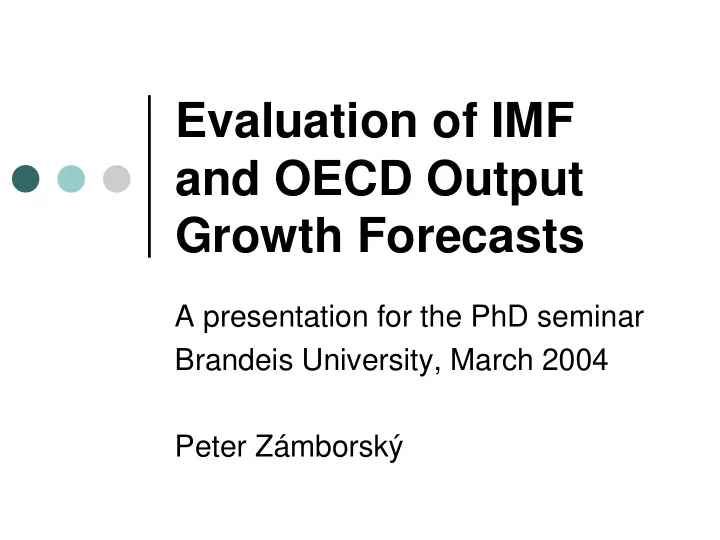

Evaluation of IMF and OECD Output Growth Forecasts A presentation for the PhD seminar Brandeis University, March 2004 Peter Zámborský
Outline � Real GDP forecasts for G7 in ’73-’01 � Same-year and year-ahead forecasts � World Economic Outlook of the International Monetary Fund (IMF) � Economic Outlook of the Organisation for Economic Cooperation & Development (OECD)
Significance � Forecasts inform our decisions � We spend lots of money on econometric models that look ahead � How good are those sophisticated forecasts compared to naive ones?
Contribution � Another macro-forecast evaluation? Yawn � Artis (‘96) and Pons (‘00) found that the IMF’s GDP forecast accuracy has not improved significantly over time � My verdict is more optimistic
Main findings (1) � IMF’s forecast accuracy compared to the OECD improved since 1987 � In 1986 the IMF invested significantly in econometric modeling
Main findings (2) � Year ahead forecasts are more than 1.0 percentage point wrong on avg � Same year forecasts >0.5 point wrong � Naïve models only about 30% worse
2001 US example � IMF Oct ’00 5.2 � OECD Dec ’00 3.5 � IMF May ’01 1.5 � OECD Jun ’01 1.7 � First available 1.2 � First settled 0.3
2002 US example � IMF Oct ’01 2.2 � OECD Dec ’01 0.7 � IMF Dec ’01 0.7 � IMF Apr ’02 2.3 � OECD Jun ’02 2.5 � First available 2.4 � First settled 2.4
IMF & OECD Year Ahead Forecasts for the US 8.0 6.0 4.0 % p o in ts IMF 2.0 OECD 0.0 1970 1980 1990 2000 2010 -2.0 -4.0 Year
Year ahead forecasts & actual values for the US 8.0 6.0 4.0 % points IMF 2.0 OECD Actual 0.0 1970 1980 1990 2000 2010 -2.0 -4.0 Year
IMF & OECD Same Year Forecasts for the US 8.0 6.0 4.0 % points 2.0 IMF OECD 0.0 1970 1975 1980 1985 1990 1995 2000 2005 -2.0 -4.0 -6.0 Year
Same Year Forecasts & actual values for the US 8.0 6.0 4.0 % p o in ts IMF 2.0 OECD 0.0 Actual -2.0 1970 1980 1990 2000 2010 -4.0 -6.0 Year
Forecast error measurements � Mean absolute error (MAE) � Root mean squared error (RMSE) � Theil’s U U = RMSE / [ ( ∑ ( A(t)-A(t-1) )² / n ) 1/2 ] A(t) is the actual value at time t n is the number of observations
Alternative Models � The random walk � A five-year average � Exponential smoother F(t) = F(t-1) + 0.25 ( A(t-1) – (F(t-1)) F(t) is the forecast at time t
Test for unbiasedness � Underprediction or overprediction? � T-test for the hypothesis that the mean forecast error γ is zero in a regression of the error on a constant e(t) = γ + v(t) e(t) is forecast error or A(t) – F(t)
Tests for efficiency � Do the forecasts reflect all information available at the time they were made? β -test e(t) = α 1 + β . F(t) + u(t) ρ -test e(t) = α 2 + ρ . e(t-1) + u(t)
Results to remember � OECD more accurate than IMF in ’73-’01 � IMF improved from ’87, winner for US � OECD forecasts deteriorated since ’87 � Naïve models 30% worse than the IMF � Year-ahead forecasts > one point wrong � Same-year forecasts > half point wrong � Upward bias (not statistically significant)
Avenues for improvement � More sophisticated error measurements (Diebold-Mariano) � More sophisticated alternative models (VAR, BVAR, structural models) � A more rigorous analysis of the impact of modeling on forecast accuracy � Micro-foundations (behavioral? public forecaster’s loss function)
Recommend
More recommend